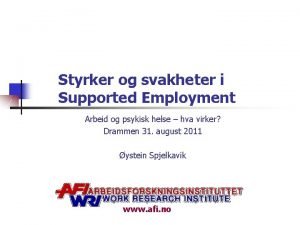EUSE QUALITY STANDARDS AND SUPPORTED EMPLOYMENT OUTCOMES Francisco

- Slides: 1

EUSE QUALITY STANDARDS AND SUPPORTED EMPLOYMENT OUTCOMES Francisco de Borja Jordán de Urríes & Miguel Ángel Verdugo (INICO, Universidad de Salamanca) Summary The EUSE quality standards(1) were developed in 2005 by a team of experts members of the European Union of Supported Employment (EUSE). Those standards were not empirically tested. In Spain, the INICO developed a tool for the application of EUSE Standards. From 2008 to 2010, this tool was applied in the context of a national project (ECA Caja Madrid Program). In this period, the program collected annual data related to quality adjustment to EUSE standards, and also related to management outcomes. Some results are presented. Objectives • Apply the assessment tool for the EUSE Quality Standards to all initiatives to keep track of the evolution of the quality of Supported Employment (SE) programs. • To analyze the relation between the level of quality of organizations and outcomes on both the organization as a whole, and workers in supported employment. EUSE Quality Standards (1) Block 1 ORGANIZATION 1. 1 Quality of Service Commitment 1. 2 Involvement of beneficiaries 1. 3 Promoting the rights of disadvantaged 1. 4 Competent workers at all levels Block 2 PROCESS Phase One: Making contact 2. 1 The person receives all necessary information Second phase: Professional profile 2. 2 Use of person-centered approach 2. 3 The aid to individuals to make realistic decisions 2. 4 It develops a personal plan flexible Third phase: Job Search 2. 5 Training and support to find employment 2. 6 Help to find the best possible job Fourth phase: involvement of the company 2. 7 Supporting the company to find right person Fifth phase: support within and outside the workplace 2. 8 Support appropriate and effective Block 3 RESULTS 3. 1 It is and remains a work in open employment 3. 2 The employee is valued and accepted 3. 3 provides opportunities for professional development Instruments • We use two different tools and a system “on line” to collect information on the programs. • Questionnaire DEA (Data on Supported Employment) was originally developed for the initial study and has been corrected and improved in each subsequent studies. • The Assessment Tool for EUSE Quality Standards was developed on the basis of the quality standards. Levels of analisys • Level 1: referring to the organizations, by linking EUSE adjustment results with program performance data. These performance data are provided annually by completing the DEA questionnaire and refer to all users in supported employment programs independently of they were funded by ECA Caja Madrid or not. • Level 2: referred to workers, by linking EUSE adjustment results with data for each individual worker contract who has received funding for being a New Insertion in the ECA Caja Madrid program, obtained through Labor Data Questionnaire. Sample • In the organizations level the sample was composed by the aggregate of all organizations participating in the ECA Caja Madrid Program: 210 in 2008, 236 in 2009, 207 in 2010. • In the workers level the sample was composed by a ramdom selection of 404 workers (352 disability & 52 social exclusion) from the 1, 637 workers between 2008 and 2010. (1) Evans, M. , Lopes, I. , Katsouda, C. , Diepeveen, A. , Fleming, M. , Haddock, M. , Hazzard, T. , Schuller, S. , Johnova, M. , Boxava, P. , Martínez, S. , Jordán de Urríes, F. B. , Eklund, B. , Sariola, L. , y Haltunen, H. (2004). Information Booklet and Quality Standards. Belfast: European Union of Supported Employment. Variables analyzed • Independent variable üStandards EUSE: 15 standards with a discrete score between 0 and 100. • Dependent variables • At the program level üTotal number of persons who have obtained employment since the start of the program, divided by the number of years of the program üTotal number of persons currently working, divided by the number of years of the program üProportion of users by type of dwelling (residence, family home, supported living, independent) üProportion of contract by type of contract (temporary or permanent) üAverage salary • At the worker level üType of working hours (partially or continuous) üWeekly working hours üMonthly Salary üType of contract (temporary or permanent) üBenefits (yes or not) Results presented sympathetically • Is there a relationship between higher scores on EUSE standards and improved outcomes in employment? NO, we have not found any significant relationship. • Not to the level of the results of the organizations and the level of workers? NO, neither • Not even distinguishing between organizations of persons with disabilities and at risk of exclusion? NO, not • Not even choosing extreme groups of organizations with high-set levels and organizations with low levels of adjustment? NO, NO and NO 3 1 2 4 • Did we find something? YES, we did!!! Diferences between goups • Organizations level (1) The adjustment level to standards is higher in disability organizations, but annual growth was greater in the social exclusion organizations. • Workers level (2) The adjustment level to standards is higher in disability organizations, but annual growth was greater in the social exclusion organizations. (3) higher wages for workers in social exclusion organizations. (4) More weekly working hours for workers in social exclusion organizations. (5) Social exclusion organizations get more permanent contracts in those with higher rates of adjustment. Some conclusions… if possible • Standards can be useful to define a framework for proper development of SE. • Probably, standards could be redefined in a more precise way by research methodology. • Can be promoted by national programs as a quality criterion. • The adjustment to standards does not seem directly related to employment outcomes. • Probably the achievement of results is more dependent on other variables than the program adjustment to quality criteria. • However we appreciate differences in practices developed by initiatives working with people with disabilities from those working with people at risk of exclusion. • It is probably necessary to deepen the differential approach between the two groups. 5

